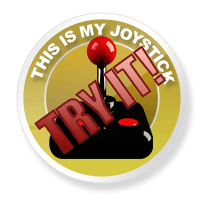Reviews
Resistance: Burning Skies
June 5, 2012, Author: Andy Corrigan
Resistance. This is a franchise for which the ongoing plaudits continue to baffle and bemuse me. When I finally laid down the cash on my PS3, all the existing owners I knew were telling me that Insomniac’s Resistance: Fall of Man and its then-only sequel were games that I absolutely must play. Existing media reviews told me the same, with words like ‘outstanding!’ and ‘exceptional!’ freely thrown around, while one even went as far as to compare it to Goldeneye 64. I was expecting big things, but after playing both games, instead of love or hate, I was left with the worst kind of feeling about them: no feeling at all.
Don’t get me wrong, neither game was inherently broken and there were some really neat ideas when it came to the arsenal; however, the action was dreary, and in both games I found myself just going through the motions, hoping the end would come sooner rather than later. Despite it being a horrible feeling when you can’t see the merits of something that many, many people enjoy, I had zero interest in revisiting the series when the third game rolled around.
However, in lieu of any new games arriving in this early portion of the Vita’s lifecycle and not being a fan of Unit 13’s repetition, I have found myself keeping one eye on the release of Resistance: Burning Skies by Nihilistic Software.
So, what we can expect now that an FPS is on a handheld that finally sports that second analogue stick?
Substance free
Burning Skies follows New York fire fighter, Tom Riley, during the start of the Chimera’s invasion on the US East coast. Heading to what he and his squaddies assume is a standard job, they find a far more vicious foe than a raging fire. After his team gets slaughtered by the invading forces and he starts to realise the gravity of the situation, Tom desperately searches out his wife and daughter.
Although it sounds like the premise for a decent plot, it’s actually rather poor. Tom is essentially an easily-distracted plank of wood with a gun attached, with very few lines of dialogue to sell his predicament. Most of the story doesn’t even follow him, with the low quality cut-scenes focusing on ugly propaganda movies, and not what’s happening to the important characters in-between levels. There are occasional cheap attempts at emotional moments, but these always fall flat. You won’t be playing this to be entertained by an enthralling plot.
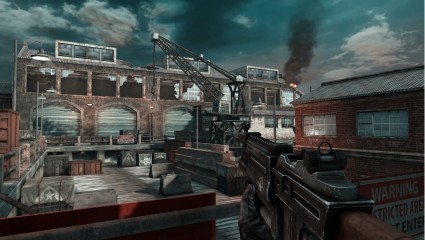
The game really doesn't look this good...
Don’t touch me…
So, the big question on everybody’s lips: does the FPS genre work on Vita? On the evidence of this game, the answer is definitely a yes; the mechanics do work well and there are good things to take away here. That said, Burning Skies as a whole is very far from a standout title.
For starters, fans of Resistance’s fast-paced gameplay, which traditionally sits somewhere between the run-and-gun antics of Halo and the twitch-shooter action of Quake/Unreal, might find the slower pace a bit of a turn off in Burning Skies. Still, the dual analogues work well in tandem, exactly as you’d hope from a console FPS, and moving and aiming is nice and smooth. It’s a huge relief as basic gameplay feels natural right from the off. What does hurt the game, though, is the way it uses (read as: ‘shoehorns in’) most of the Vita’s unique features, along with some odd design decisions.
The key example to this is how secondary fire from any gun is managed with the touchscreen in some shape or form. While not a terrible idea to use the touchscreen in some capacity, the implementation here is pretty hit or miss across the arsenal. So, firing your Carbine’s grenade requires you to take your thumb away from the right stick and drag an aiming reticule over to where you want it shot, and it’s the same for tagging enemies with the Bullseye. Not only is this as disorientating in the midst of a firefight as it sounds, you’re also obscuring your view with your own thumb.
Admittedly these are things that you get used to over the course of the game, but it’s disappointing when actions such as deploying your Auger shield or reloading the crossbow that adorns the Mule (shotgun) both fare better with smarter, quicker actions. The auxiliary actions, such as mêlée attacks or detonating explosives, appear as additional buttons around the edge of the touchscreen. These are better for the flow of gameplay, being more comfortable to reach.
Running is another thing that’s clumsily handled when it comes to touch implementation. When walking forward, a quick double-tap of the backpad should see you run for a short period in that direction, but it often doesn’t register. Thankfully there’s a better, alternative method in holding down on the D-pad, but that doesn’t stop the fact that good ol’ Tom, despite being a fireman by trade, has a small threshold for exercise and instead of slowing down, simply stops dead on the spot no matter which option you use.
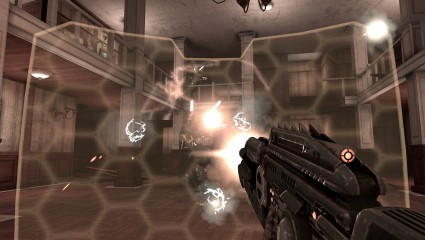
Deploying the Auger shield via touchscreen is easy; other actions don't fare so well...
Despite these issues, I’d be lying if I said that the combat was totally devoid of fun. The weapon-set from the PS3 games is impressively present and correct, and all guns operate with their standard functionality intact. There’s a pretty decent upgrade system in place for them too. You’ll find glowing blue cubes around the environments that can be spent on one of six upgrades for each weapon. You can increase things like range and damage, or something that drastically changes how the weapon works, such as a scope in the Carbine’s case. Just note that only two upgrades can be active at any one time, though once unlocked you can change them around whenever you like.
While there isn’t a great showcase of A.I. to be found by any stretch, the Chimera at least press hard and in enough numbers to pose a threat, offering some challenging moments. In fact, the best moments come when the otherwise stunted level design allows them to do just that. Unlike the game’s many dull corridors, the larger environments provide plenty of cover and vantage points for the Chimera to pin you down from.
There is a basic cover mechanic here for you too, for that matter. If you’re crouched behind small cover or next to a corner, pulling the left shoulder button will bring you out of cover to shoot, while releasing will put you back safely where you were. It works very nicely and comes in handy for allowing your auto-heal to kick in. It’s especially useful when under fire from snipers. The game can occasionally be picky about what surfaces you’re allowed to use as cover, though, so just be warned.
Though the general combat can be fun under the right conditions, it’s a huge shame that boss encounters are pretty boring on the whole. Despite the threateningly impressive scale, they offer very little in the way of menace or challenge outside of ‘shoot baddie in its weak spot’. When an enemy is the size of a sea liner, you’d expect to be in combat for more than a few minutes, wouldn’t you?
It’s that which most sums up the single-player campaign: it often hints or promises something better, but rarely delivers on it.
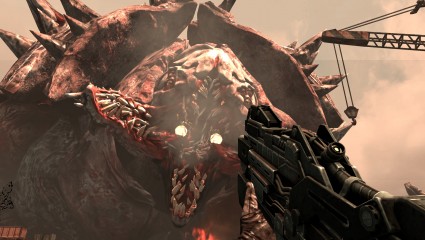
This boss fight took under a minute after I'd worked out what I needed to do...
It’s a blur!
Visually, it’s not a promising sight when the first thing that greets you in a campaign is the most overly compressed, blocky and low-quality video you’ll ever see in a video-game. Frankly, it’s a crime against the Vita’s lovely, high-resolution screen to see it abused in this way. Thankfully, things get better in gameplay, but there’s still a lot left to be desired.
It’s plain to see that the game generally looks nice in motion, but it feels unfinished and inconsistent in some parts. This is evident in the dreary corridors you’ll often walk down, but its lack of polish is highlighted more so in the glitches that can occur.
There were moments when crossing a bridge, for example, where if I looked just enough away from the sides, the detail below would disappear to be replaced by a white texture. In a lot of the indoor environments you’ll occasionally see a line of white dots flicker, PSOne-style, along some of the textures in the walls.
In combat, dead enemy bodies disappear, which is expected on a handheld. However, they shouldn’t suddenly slide off the side of the screen and stretch their polygons when they do so, which is something else I caught occasionally. All of this makes the game feel patchy.
The guns at least look absolutely flawless. I think they’ve done a great job there, even to the degree to which their look evolves as you add upgrades. Character models were also rendered just about decently enough, with Ellie and other NPCs showing notable facial animation during the in-engine cut-scenes.
What sound?
Audio, is without a doubt, the most broken aspect of the game. The very sparse voice acting is passable, but it sometimes doesn’t kick in when it should. Early on there was an encounter between Tom and his wife and daughter, which would have been one of the very few touching moments in the game, but then I had to pause and switch on subtitles to see what they were saying. This happened once more, and happened very occasionally with weapons.
The guns do pack a punch, but that’s all they can do, because the audio engineering is so poorly executed. Firing a gun literally overpowers everything. While there is a soundtrack on the main menu, it’s painfully underused in-game, meaning Burning Skies never feels like it’s building to anything.
There’s no atmosphere at all, no tension. All you’ll ever really hear are the same set of footsteps interspersed with gunfire. When the fight dies down, it’s back to rhythmic footsteps, unless Ellie wants to say something uninspiring…
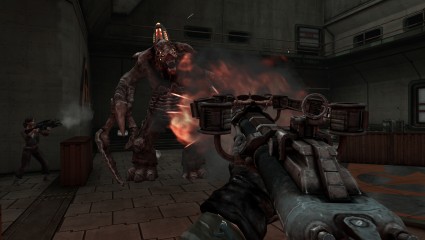
Ellie isn't much use, unfortunately.
A problem worth persevering with…
Multiplayer is one element that does make up for some of the game’s other shortfalls and at least provides a reason to revisit once you’re done with an average campaign. It’s not entirely perfect in its current state, but it’s the best attempt at a handheld online FPS that I’ve played to date. It’s certainly the closest to a home console experience I’ve seen, even with its issues.
Some reviews have complained that it’s a basic affair, short on modes, but I think that there’s enough here to keep you busy if you consider that it’s a portable game. It’s something you’ll tend to play in short bursts and when your format of choice isn’t freely available. There are three modes on offer over six maps, and although Deathmatch and Team Deathmatch are obvious and self-explanatory choices, you can play with up to eight players or take to smaller, four player battles on either mode.
The other option is Survival, where the human team initially outnumber the Chimera, but as each human dies, they become Chimera, and the humans must simply survive until the end of the round. It is pretty fun, truth be told.
There’s a fun but small-scale unlock system in place, which allows you to customise your loadouts, picking your weapons and their perks once unlocked. It’s basic compared to, say, Max Payne 3, but for a handheld title it’s probably just enough.
Here’s the bad stuff. Unfortunately, you’ll find some issues getting into a match. There has been a patch since I first received my copy that has improved matchmaking a little, but it’s still a tad problematic and it can take a while to find a room that runs smoothly. Even then, once in a match you’ll sometimes be subjected to occasional glitches and hiccups. Hopefully they’re still working on these teething issues, because the bones of a decent online shooter exist here. When it works, it works well.
Remember that crap audio engineering? It makes the process of determining where the action is a nightmare. If you’re looking for enemies and hear gunfire, you will not be able to tell where it is coming from, be it how far away or from which direction. All of the gunfire happens at practically the same volume, and not even headphones can save you. Audio in online games can often help with that fine line between life and death, and in this respect, Burning Skies lets you down completely.
Resistance is futile. Take that as you will…
Being generous, Resistance: Burning Skies can only ever be described as a ‘serviceable’ FPS. It works, doesn’t push any boundaries, but it’s seemingly happy to just be the first handheld twin-stick FPS on the market, rather than trying to set the bar high for all that follow it.
What it at least does in its own slapdash way, is prove that the FPS genre should have a bright future on the Vita going forward. In this instance, however, it’s hard to recommend it when it feels so unfinished and the bulk of touchscreen implementation falls so short of the mark.
While I’m not sure that even the most hardcore of Resistance fans will find everything they’re looking for, if you’re really hurting for something new to play on Vita or you’re curious as to whether the FPS can handle well enough on Sony’s system, then it’s probably worth your time. Give it a miss if you’re expecting top-class shooter thrills with high production values, though, or it won’t just be the skies that get burnt.
Platforms: PS Vita | Tagged Chimera, first person shooter, FPS, Nathan Hale, PS Vita, Resistance, Resistance 2, Resistance 3, Resistance: Fall of Man, Vita


